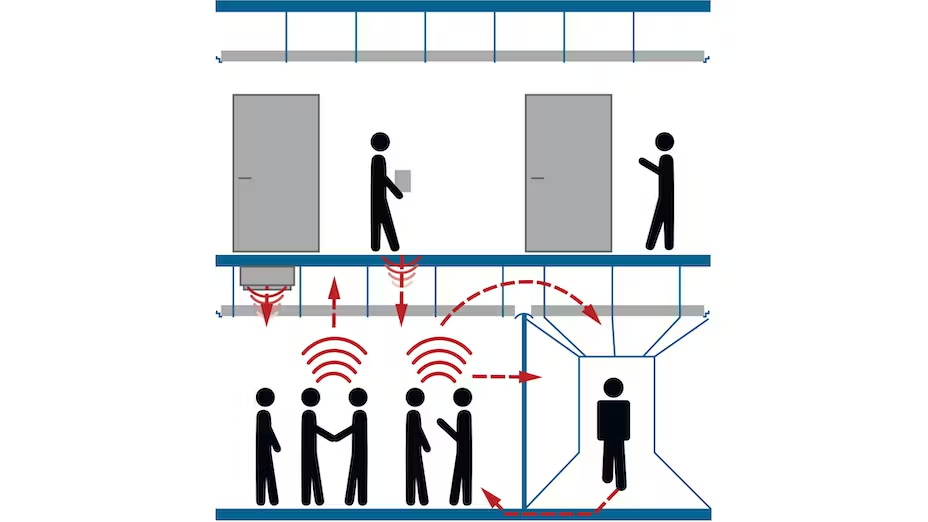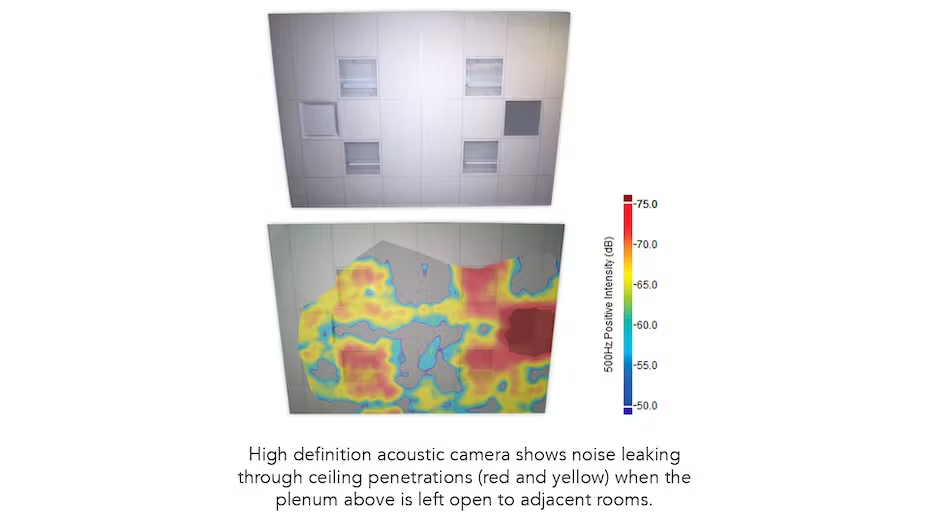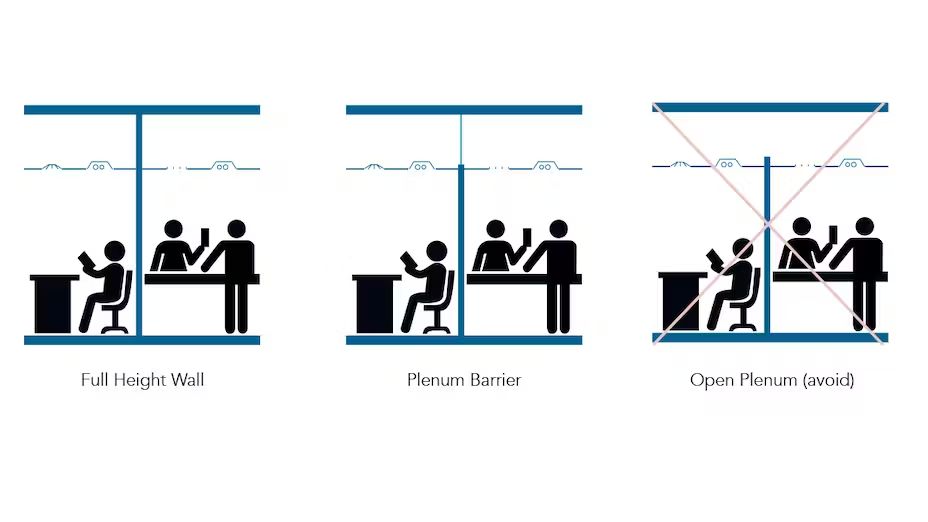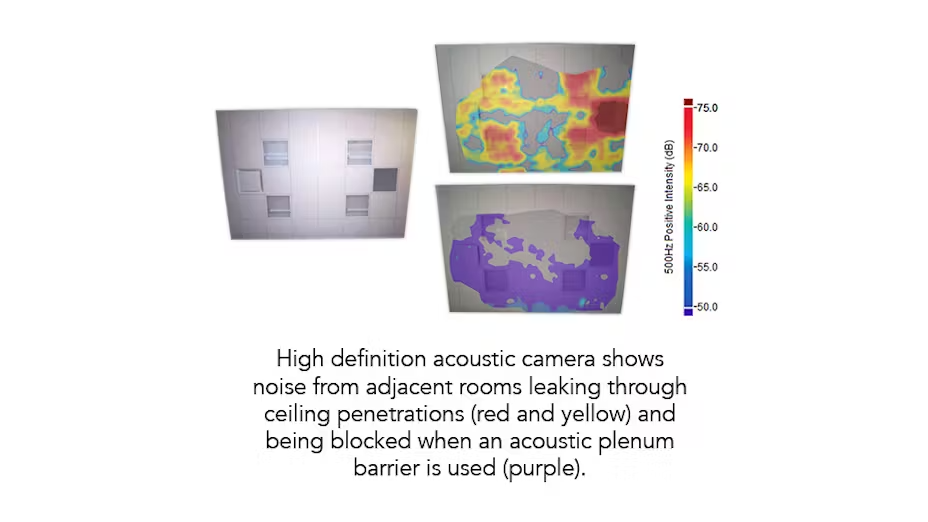It is better to soundproof and block sound with a solid wall extending from floor to ceiling rather than just up to the acoustic ceiling. Right or wrong? That is a question we often get from customers.
Before deciding to build partition walls that extend only to a dropped acoustic ceiling instead of reaching the structural ceiling, ask yourself:
Is this truly the best decision for your project, or is it driven by budget constraints?
Will it provide the most effective soundproofing solution?

The Impact of Poor Acoustic Quality
Surveys conducted on buildings after they become operational show that people often complain about acoustic quality, particularly speech privacy. Poor acoustics are common in open spaces and also occur in poorly designed private rooms.
In large, crowded areas, we do not expect complete speech privacy. However, in private rooms, people expect confidentiality when they close the door. The question is: Does the space actually provide the desired level of privacy? The answer depends on whether partition walls extend to the structural ceiling or only to the dropped acoustic ceiling.
Before making a decision, consider the weight of a full-height partition wall compared to the lightweight, perforated acoustic ceiling tiles used for lighting and HVAC installation. Acoustic ceilings alone are inadequate for blocking sound. This is why building standards, guidelines, and rating systems require full-height walls with high Sound Transmission Class (STC) ratings—higher STC ratings mean better soundproofing.
What Is Soundproofing?
Soundproofing (also known as sound isolation) occurs when a large, non-porous, dense architectural surface—such as a multi-layer drywall partition or a concrete floor/ceiling—reflects sound energy instead of allowing it to pass through.
Since sound waves are reflected rather than transmitted, minimal sound reaches adjacent rooms. Effective soundproofing ensures speech privacy and noise control.
DASM optimizes acoustic design by using full-height walls with high noise-blocking capabilities or by combining lightweight partitions above an open ceiling with mineral wool acoustic and soundproofing panels to ensure speech privacy.

Soundproofing in Building Standards, Guidelines, and Rating Systems
More buildings and room types are now required to meet strict soundproofing criteria in construction standards and rating systems.
Healthcare Facility Guidelines published by the Facility Guidelines Institute (FGI) state: “Soundproofing must be considered in all construction projects that involve space division.”
The WELL Building Standard, applied to commercial office buildings, states: “Noise from surrounding spaces can be disruptive and negatively affect the human nervous and immune systems.”
The Collaborative for High Performance Schools (CHPS) emphasizes that “students struggle to learn in poor acoustic environments, where excessive noise negatively impacts verbal communication” (EQ14.0). All learning spaces must meet minimum soundproofing performance levels.
How Is Soundproofing Measured?
Required soundproofing levels between rooms are determined by one of two methods in building standards:
Minimum STC rating for full-height walls (from floor to ceiling)
Minimum Noise Isolation Class (NIC) rating for the entire constructed room enclosure
Ceiling Attenuation Class (CAC) ratings are not recommended, as they apply to a design approach that is generally not accepted.
Sound Transmission Class (STC)
STC is a laboratory-measured rating of a wall assembly’s soundproofing performance. STC ratings also apply to doors, windows, and floor/ceiling systems. Higher STC values indicate better soundproofing between rooms.
To determine an appropriate STC rating for a wall, consider:
The function of the rooms
The occupants’ sensitivity to noise
The expected noise levels
Building standards typically require STC ratings of 40, 45, or 50, with more critical applications requiring STC ratings above 50. If a wall has an STC requirement, it must extend from the floor to the structural ceiling—not just to a dropped ceiling, leaving a gap above. STC ratings are determined using ASTM E90 standards.
Noise Isolation Class (NIC)
NIC is an on-site measurement of the total sound isolation between two rooms after construction. Higher NIC values indicate better soundproofing.
Unlike STC, NIC accounts for all sound paths, including:
Walls
Doors
Windows
Gaps where sound can leak
NIC is often preferred in building standards because it reflects real-world acoustic performance. Typical NIC values for general applications are 35, 40, or 45. NIC ratings are determined using ASTM E336 standards.
Ceiling Attenuation Class (CAC)
CAC indicates how well a dropped ceiling blocks sound transmission through the ceiling plenum when walls do not extend to the structural ceiling.
Higher CAC values mean better sound blocking between rooms. Most acoustic ceiling tiles have CAC ratings between 20 and 35, with some reaching 40 or slightly higher. However, when lighting fixtures and HVAC components are installed, CAC performance drops by 10 points.
Because dropped ceilings cannot provide adequate soundproofing, CAC is not recognized by most building standards. CAC ratings are measured using ASTM E1414 and ASTM E413 standards.
Understanding Soundproofing in Buildings and Room-to-Room Noise Control
The effectiveness of soundproofing between rooms on the same floor primarily depends on walls and doors.
In the past, some buildings used partition walls that stopped at the dropped ceiling, leaving an open plenum above. Many designers were unaware that:
Soundproofing is significantly reduced when walls do not extend to the structural ceiling.
Dropped ceilings have lower CAC ratings (20–35) compared to typical wall STC ratings (40–50).
A typical ceiling system has 10–20 points lower soundproofing capability than a wall.
Even though most modern building codes do not recognize partial-height walls, some older and even newly constructed buildings still use them.
Relying on a dropped acoustic ceiling for soundproofing is a risky design choice and is not recommended. Some ceiling manufacturers still market their products as “noise-blocking,” but modular acoustic ceiling panels alone cannot block sound effectively due to their low mass.
Additionally, sound leaks occur when ceiling panels are installed alongside standard suspension systems and other building components, such as:
Air diffusers (left)
Lighting fixtures (center)
Return air grilles (right)

Acoustic specialists use high-resolution sound cameras with intensity probes to visualize noise leaks through ceiling systems (seen as red and yellow areas in thermal-like imagery). These leaks greatly reduce acoustic performance, sometimes cutting noise-blocking effectiveness by 50%—allowing sound to pass freely between rooms.
How to Optimize Soundproofing Between Rooms
How to Optimize Soundproofing Between Rooms?
DASM’s optimized acoustic solutions align with building standards, guidelines, and rating systems when walls are built to the full ceiling height and rated for STC to block noise between rooms. Constructing walls only up to a suspended ceiling while leaving the upper portion open allows sound to travel between rooms. This design approach is not permitted, and no effective noise-blocking solution can compensate for this design flaw.
Ventilated Ceilings
Increasingly, building standards, guidelines, and rating systems encourage designers to use lightweight acoustic barriers above suspended ceilings to block sound transmission when room partitions only reach the ceiling grid. This is necessary because standard ceiling panels do not provide sufficient speech privacy. Combining acoustic ceilings with additional barriers above ventilated ceilings helps match the STC performance of partitions below.

Avoid leaving the ventilation shaft open as it does not comply with sound standards.
Noise-blocking partitions above ventilated ceilings provide an effective solution, extending from the top of the room partition below the suspended ceiling all the way to the underside of the floor or roof above.
Two Options for Optimized Room Soundproofing:
Full-height walls – Extending partitions up to the structural ceiling.
Ceiling noise barriers – Using lightweight sound-blocking panels above ventilated ceilings.
Avoid leaving open ventilation gaps, as this does not comply with acoustic standards.
Choosing the Right Sound Transmission Class (STC) Rating
DASM’s acoustic experts can help you determine the appropriate STC rating. First, they assess the level of noise generated by people and equipment in adjacent rooms. Then, they consider the activities occurring in the space, the sensitivity of occupants to disruptive noise, and the level of speech privacy required.
STC 50+ → Best soundproofing quality
STC 45 → Very good soundproofing
STC 40 → Good soundproofing
Avoid STC below 40, as it does not provide adequate acoustic privacy.
Designers can achieve these performance levels by using full-height partitions or a combination of acoustic ceilings and additional noise barriers above ventilated ceilings.
If an adjacent room contains many people or machines, and noise transmission would interfere with the intended activities, an STC 50 rating is recommended. For example, STC 50 is ideal for classrooms and spaces requiring high levels of confidentiality, such as executive offices.
If the adjacent room is frequently occupied but its primary function is not highly sensitive to sound, an STC 45 rating is suitable. This applies to standard offices, private workspaces, and patient rooms in healthcare facilities.
Why Are Ceiling Noise Barriers More Effective Than Just Acoustic Ceilings?
High-resolution acoustic cameras combined with sound intensity probes demonstrate the difference between using only room partitions up to an acoustic ceiling versus enhancing the ceiling’s performance with additional barriers above.
Acoustic imaging reveals noise transmission through mineral wool ceiling panels with a high Ceiling Attenuation Class (CAC) of 37, showing red and yellow areas where sound leaks most. These include return air vents, recessed lighting, air supply diffusers, and ceiling-wall junctions. These leaks can reduce the CAC rating by 10 points, from 37 to just 27.
When using mineral wool ceiling tiles in combination with an overhead noise barrier, sound leakage disappears. DASM’s optimized solution operates at STC/CAC 40, 45, or 50, depending on the specific combination of ceiling and additional barriers. This significantly lowers noise levels—by over 25 decibels—compared to using only ceiling tiles.

When to Use Ceiling Noise Barriers Instead of Full-Height Walls?
From an acoustic standpoint, full-height walls are the preferred design in most cases. If a building must comply with STC-rated standards, guidelines, or rating systems, full-height walls should be constructed. However, emerging guidelines and rating systems allow designers to choose between lightweight overhead partitions and full-height walls based on cost-effectiveness and installation complexity.
In some architectural designs, full-height walls are not practical. A common example is modular wall systems, which are pre-manufactured and typically installed below suspended ceilings. These systems do not extend to the structural ceiling. Instead of adding drywall extensions or leaving gaps, DASM recommends lightweight ceiling noise barriers as the optimal solution.
Similarly, when raised floors create an open cavity below, an additional floor barrier should be installed to maintain the soundproofing effectiveness of the walls above.
Many buildings constructed in the 1980s and 1990s made the mistake of relying solely on CAC 35-rated suspended ceilings for noise control while using partitions that stopped at the ceiling. Today, we are still dealing with the acoustic challenges of these buildings. As acoustic knowledge and noise-control requirements evolve, complaints about poor speech privacy have increased. Ceiling noise barriers offer a practical retrofit solution in such cases, as rebuilding full-height walls is often impractical and costly.







